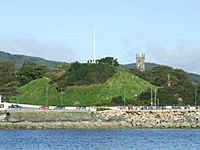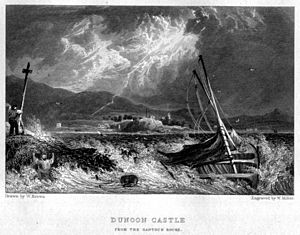Dunoon Castle facts for kids
Quick facts for kids Dunoon Castle |
|
|---|---|

Castle Hill Dunoon - geograph.org.uk - 995906
|
|
| General information | |
| Status | No longer standing |
| Location | Argyll and Bute, Scotland |
| Address | Castle Gardens |
| Town or city | Dunoon |
| Country | Scotland, United Kingdom |
| Coordinates | 55°56′44″N 4°55′26″W / 55.945599°N 4.9238077°W, National |
| Designations | Scheduled Monument: SM5450 |
Dunoon Castle is a very old castle that is now in ruins. It is located in Dunoon, a town on the Cowal peninsula in Argyll and Bute, Scotland. The castle was built on top of a cone-shaped hill, which was about 80 feet (24 meters) high. This hill was actually a volcanic plug, a type of rock formation.
Today, not much of the original castle structure is left. The remains of the castle and the land around it are protected as a "scheduled monument." This means they are important historical sites.
In the 14th century, Dunoon Castle was a royal residence, meaning kings and queens lived there sometimes. By the 17th century, it had fallen into ruins and was no longer used.
Contents
History of Dunoon Castle: A Look Back in Time
Early History: 13th-15th Century Beginnings
The first records of Dunoon Castle appear in the 13th century. It might have been built as the Stewarts family became more powerful in the Cowal area.
In 1333, the castle was attacked and captured by Edward Balliol, who then gave it to Edward III of England. But soon after, a rebellion started, and Balliol was forced out of Scotland. Robert the Steward, who later became Robert II of Scotland, came to Cowal. With help from Colin Campbell of Lochow, he managed to take the castle back.
By the 15th century, Dunoon Castle was known as a royal castle. The Campbells family were the traditional keepers of the castle for the Scottish Crown.
16th Century: Royal Visits and Battles
In 1544, Dunoon Castle was attacked again, this time by Matthew Stewart, 4th Earl of Lennox. He had 18 ships and 800 soldiers, given to him by Henry VIII of England. Lennox successfully captured both Dunoon Castle and Rothesay Castle. Archibald Campbell, 4th Earl of Argyll, who was in charge of Dunoon, was forced out and lost many men.
In 1563, Mary, Queen of Scots, visited the castle. She stayed there while visiting her half-sister, Lady Jean Stewart, who was the Countess of Argyll. During her visit, Mary signed several important documents. Later, in 1565, during a conflict known as the "Chaseabout Raid," rebels against Mary met at Dunoon. These rebels included important figures like the Duke of Châtelherault and the Earls of Argyll and Rothes. They left Dunoon on August 18, 1565, to continue their actions.
17th Century: Changes and Destruction
After a period when bishops were brought back to the church under Charles II of England, Dunoon Castle became a home for the bishops of Argyll for some time.
However, the castle was eventually destroyed in 1685. This happened during a rebellion led by the Earl of Argyll against King James VII and II.
20th Century: Wartime Role
Even though the castle was in ruins, its location was still important. During World War I and World War II, military defenses were set up at Dunoon Castle. These defenses were there to protect the River Clyde and the important shipbuilding industry in the area.


